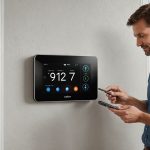Understanding Smartphone Hotspot Functionality
A smartphone hotspot allows your device to share its mobile internet connection with other devices, such as laptops and tablets. This feature extends your smartphone’s internet access to nearby devices by creating a small Wi-Fi network. Understanding the basics of mobile internet and how a hotspot functions is crucial for users relying on tethered internet connections.
Tethering works by linking your phone to other devices through Wi-Fi, Bluetooth, or USB. It’s beneficial for users who need internet access on the go without a traditional Wi-Fi network. Tethering offers flexibility in accessing the internet, making it an essential tool when reliable internet is unavailable.
Also to see : Revolutionizing Mental Wellness: Cutting-Edge AI-Powered Mobile Applications for Enhanced Monitoring and Support
Optimizing hotspot settings can significantly enhance connectivity and speed. Proper configuration can prevent slowdowns and ensure efficient data use. Key settings include choosing the correct band (2.4 GHz vs 5 GHz), setting data usage limits, and securing the connection with a strong password. These adjustments are vital for maximizing your mobile internet experience while protecting against unauthorized access and data overages.
Essential Settings for Optimizing Your Hotspot
To ensure your smartphone hotspot is operating at its best, paying attention to essential hotspot settings is crucial. Adjusting these settings can significantly impact your connection speed and overall efficiency. First, set your mobile data limits. This is vital for managing your mobile data usage effectively, preventing unexpected overages. Make sure to distribute bandwidth wisely, especially when multiple devices are connected to your hotspot.
Also to see : The Definitive Handbook for Stunning Mobile Photography: Expert Techniques for Taking Breathtaking Smartphone Images
Configuring security settings is another pivotal step. Protect your hotspot by enabling encryption—preferably WPA2 or WPA3—and set a strong password. This prevents unauthorized access and ensures that only trusted devices can connect.
Additionally, selecting the appropriate Wi-Fi band can optimize your connection. Most smartphones offer 2.4 GHz and 5 GHz options. The 2.4 GHz band provides a wider range but might be slower, while the 5 GHz band typically offers faster speeds but within a shorter range. Based on your surroundings, choose the band that best suits your needs.
By focusing on these hotspot settings, you ensure a stable and secure mobile internet experience while maximizing the potential of your smartphone’s connectivity capabilities.
Troubleshooting Common Hotspot Issues
When engaging with a smartphone hotspot, connectivity problems may occasionally arise, impeding effective use. However, hotspot troubleshooting can offer timely solutions. It’s often worthwhile to first identify whether the issue is with the initial mobile internet setup or if it’s isolated to the tethered devices.
Here’s a simple approach to resolve connectivity issues:
- Restart your devices, which can remediate temporary glitches in connections.
- Check if there are software updates available for your smartphone; older versions can cause compatibility issues with the latest network protocols. Regular updates are crucial for maintaining optimal hotspot functionality.
- Ensure that data settings, including the tethering feature, are correctly configured on your device.
If connectivity issues persist, verify that the mobile internet settings accurately reflect those required by your carrier. Sometimes, resetting these to default can restore normal operations. Lastly, monitor your device’s signal strength—intermittent or low strength may require repositioning your device or adjusting how close tethered devices are. Each of these steps equips you with practical knowledge to improve hotspot reliability.
Comparing Hotspot Capabilities Across Smartphones
Exploring the smartphone comparison for hotspot features reveals intriguing differences in hotspot performance and mobile device capabilities. Superior models offer advanced tethering, enabling faster and more reliable connections. For instance, brands like Samsung, Apple, and Google provide variable options in data speed and range, influenced heavily by their hardware and software integration.
Hotspot performance varies, with devices supporting differing levels of connectivity and speed. Usually, premium devices incorporate the latest network bands, offering expansive tethering experiences. In contrast, budget models may limit the number of concurrent connections or provide suboptimal data speeds.
Key, when considering mobile device capabilities, is evaluating battery life during hotspot use. Devices with larger batteries fare better, sustaining longer tethering sessions without frequent recharges. For an optimal mobile internet experience, consider both the phone’s processing power and its network compatibility, including 4G or 5G support, to ensure robust hotspot usage.
Ultimately, selecting a smartphone with advanced hotspot capabilities involves weighing these factors against personal usage needs. Understanding these differences empowers consumers to make informed decisions, ensuring they invest in a device that aligns with their connectivity demands.
Advanced Tips for Enhancing Mobile Internet Experience
Enhancing your mobile internet optimization involves strategic measures. Begin by managing your data efficiency. Disable automatic updates on connected devices to conserve bandwidth. Opt for data-saving settings within apps to prevent unexpected data usage spikes. Adjusting these settings helps maintain robust connection speeds without breaching data limits.
For those seeking advanced tethering improvements, utilise third-party apps designed to enhance mobile internet performance. Tools like network optimizers can allocate bandwidth more effectively, prioritising critical connections over less important ones. These apps provide customisation options that your phone’s native settings may lack, offering enhanced control over your hotspot.
When handling multiple connections to your smartphone hotspot configuration, it’s crucial to distribute data efficiently. Limit background activity on each connected device to optimise connection speed. If available, use the 5 GHz band for high-priority tasks, reserving the 2.4 GHz band for devices where speed is less critical. Balancing these can significantly enhance the overall internet experience without compromising individual connection quality.
Implementing these strategies not only bolsters immediate performance but also extends the longevity and reliability of your mobile internet setup.











